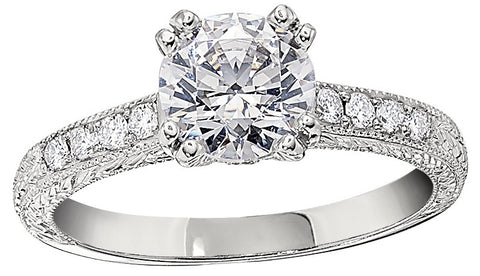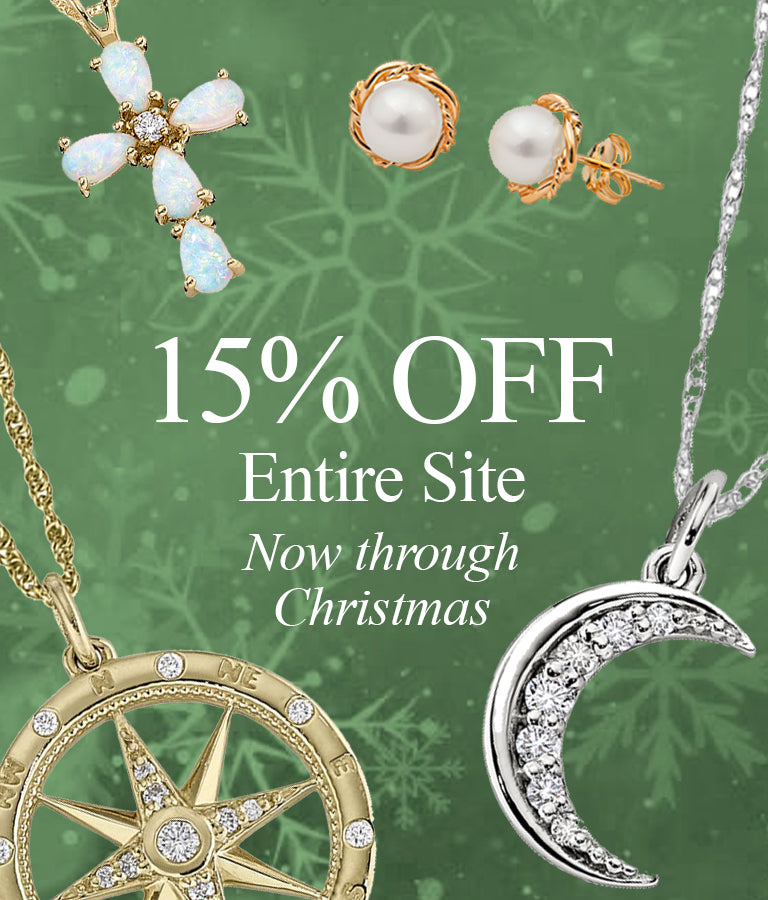Learn To Describe Engagement Ring Settings (Part I)
Shopping for an engagement ring without learning the lingo is like shopping for a car by asking for something with four wheels and a gas pedal. Not only will shopping be easier, but you will make a better purchase if you can explain what you want and understand the information you are being given. Here is the first in a series of helpful guides to teach you the basics of engagement ring vocabulary. Learn this and it will make the entire process of buying an engagement ring much easier.
When it comes to an engagement ring think of your purchase as a recipe. Different ingredients make different rings. Once you identify what 'ingredients' you want you can start to design your own engagement ring to your exact specifications. Here are the main ingredients that go into an engagement ring:
- Diamond
- Silhouette
- Head
- Shank
- Metal
Engagement Ring Settings: The Diamond
Selecting the perfect diamond takes a basic understanding of gemology. These sliding diamond scales on the Gemological Institute of America's website are an excellent tool to understand the 4C's of diamonds:
While, many brides often ask for a 'flawless diamond,' the gemological description of flawless is more than the eye can see, and most likely more than you really need to dedicate your budget to. Working with an expert, like those at Bella's, and using this chart will help you find the perfect diamond for your ring. You will also want to decide on the stone shape and carat size. The most popular stones, and the most price friendly, are rounds, though some fancy cut diamonds may offer a visually larger size at a lower carat weight making them possibly budget friendly.
Engagement Ring Settings: The Silhouette
There are really two different types of engagement ring silhouettes: solitaires and diamond mountings. Each style has its benefits. Here they are:
Solitaire - Any engagement ring settings that have only one center stone and no additional stones are solitaires. However, not all of them are what we would consider a classic solitaire with a simple band and a traditional ring setting. Some solitaires can have decorative elements, such as hand engraving, two tone details, or ornate embellishments. Solitaires allow you to focus your engagement ring shopping budget on getting an amazing stone.
Ornate Solitaire Engagement Ring Settings
Diamond Mountings - When engagement ring settings have stones, other than the center stone they are considered a diamond mounting. These include classic diamond band engagement rings, three stone engagement rings, and halo engagement rings. Diamond mountings can also be used for gemstones rings, such as emerald, ruby, or sapphire engagement rings. The benefit of a diamond mounting is they can be spectacular and decorative.

Once you have identified the silhouette you want you can explore all the variations I described and find your perfect category of rings.
Engagement Ring Settings: The Head
The actual setting the main diamond sits in is called a 'head.' Heads are most easily categorized by how they hold a stone. The most popular settings are Prong and Bezel:
Prong Settings - Prongs are thin metal projections that hold the stone. Typically they can range in numbers from 4 to 6 prongs on a head. They can be simple single metal projections or ornate fishtails. Here is an example of both a straight prong and a fishtail prong;
Straight 4 Prong Engagement Ring Settings

Fishtail Prongs Engagement Ring Settings with Hand Engraved Details
Bezel Settings - When a diamond is surrounded by a collar of metal it is called a bezel. However, if the collar goes around opposing sides of the stone it is called semi-bezel. These types of settings are typically seen on more modern settings and are ideal for athletic engagement rings because of the protection they offer. Here is a full bezel solitaire:

Bezel Engagement Ring Settings
Engagement Ring Settings: The Shank
The band that wraps from the setting around the finger is called the 'shank.' They can be all metal or embellished with stones. Here are some of our most popular shanks:
Plain Shanks - These are plain metal shanks with out any ornamentation, diamonds, or other details. Often high polished (very shinny) and clean looking they can range in width, height, taper, as well as the silhouette of the band including domed, squared, or knife edged.
Plain Shank Low Domed Engagement Ring Settings
Decorative Shanks Without Diamonds - These diamonds go to show you that you don't need diamonds to be fancy! They can have decorative elements such as sculptural reliefs, hand engraved details, or mixed metals.
Decorative Shank Without Diamonds, With Hand Engraved Details
Split Shanks - When the shank splits from the base of the shank into to separate bands that reach up to the setting, we call this a split shank. They can be plain or embellished with diamonds.
Split Shank Engagement Ring Settings
Goose Neck Shanks - When the shank broadens at the shoulders (where the shank meets the setting) and abruptly pinch in to create an almost an arrow or tear drop shape, we call this a goose neck or pinched shoulder shank. These settings help draw the eye to the center stone.
Goose Neck Engagement Ring Settings
Channel Set Shanks - Settings with diamonds set into the metal are typically called channel set shanks. However, there are a few settings that look like they are channel set but are really prong set. Regardless, it's a sleek and beautiful ring setting.
Channel Set Engagement Ring Settings
Prong Set Shanks - When small prongs hold diamonds on the shank these are called prong set shanks. The stones can share prongs, as in common prong styles, or have individual prongs.
Common Prong Set Engagement Ring Settings
Eternity Band Shanks - When the decorative elements of the shank wrap all the way around the finger it is considered an eternity band shank. These rings are symbolic of the eternity of love. Very romantic!
Eternity Band Engagement Ring Settings
Many engagement ring settings are a hybrid of these types of shank. Perhaps you want a "channel set eternity band" or a "goose neck shank with a decorative hand engraved millgrain edge", regardless of what you want, learning to describe them will help you arrive at your perfect ring much faster (and much less stressful).
Engagement Ring Settings: The Metal
When it comes to engagement ring settings, long gone are the days of the 'it' metal. Sure, 10 years ago you had to have a white gold setting. Today, the bridal world is open to any metal you desire, especially when it comes to mixed metal rings such as pink and green gold engagement rings and white and rose gold engagement rings!



















